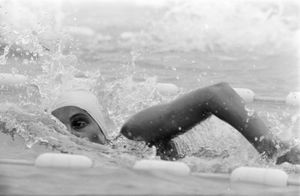Swimming Overuse Injuries
This article or area is currently under construction and may only be partially complete. Please come back soon to see the finished work! (11/09/2019)
Original Editor - Your name will be added here if you created the original content for this page.
Top Contributors - Lucinda hampton, Kim Jackson, Wanda van Niekerk, Jacob Bischoff and Mohit Chand
Introduction[edit | edit source]
Swimming is a great sport enjoyed by all age groups at all levels of ability. It is a unique sport that in that it combines upper and lower extremity strength exercises with cardiovascular training in a nonweightbearing environment. Swimmers are unfortunately prone to injuries. Most swimming injuries are classed as overuse injuries and relate to faulty biomechanics The most common swimming injury regions are the shoulder, neck, lower back, and knee.
Swimming overuse injuries usually arise from one or a combination of the below
- Poor stroke mechanics
- Poor breathing technique
- Poor flexibility or range of motion eg of neck or low back
- Hyper flexibility of joints with insufficient muscular stabilisation
- Decreased rotator cuff or scapular muscle strength
- Insufficient core strength/stability
- Decreased hip muscle strength
- Overtraining
- Not enough rest periods
A 2012 study into epidemiology of swimming injuries highlighting that "An understanding of swimming biomechanics and typical injuries in swimming aids in early recognition of injury, initiation of treatment, and design of optimal prevention and rehabilitation strategies"[1]
Swimmers Shoulder[edit | edit source]
Shoulder pain is the most frequent orthopaedic injury in swimmers, with a reported prevalence between 40% and 91%[1]
Swimmers Neck[edit | edit source]
Swimmers Back[edit | edit source]
The spine is also a recognized site predisposed to injury in the elite swimmer, mainly associated with butterfly swimmers ( 33.3%-58%) and breaststroke swimmers (22.2%- 47%), figures varying from differing studies.
Swimmers Knee[edit | edit source]
Knee pain figures range from 34% to 86% for a single knee episode, being highest in breaststokers,[1]
Resources[edit | edit source]
- bulleted list
- x
or
- numbered list
- x
References[edit | edit source]
- ↑ 1.0 1.1 1.2 Wanivenhaus F, Fox AJ, Chaudhury S, Rodeo SA. Epidemiology of injuries and prevention strategies in competitive swimmers. Sports health. 2012 May;4(3):246-51. Available from: https://www.ncbi.nlm.nih.gov/pmc/articles/PMC3435931/ (last accessed 11.9.2019)







